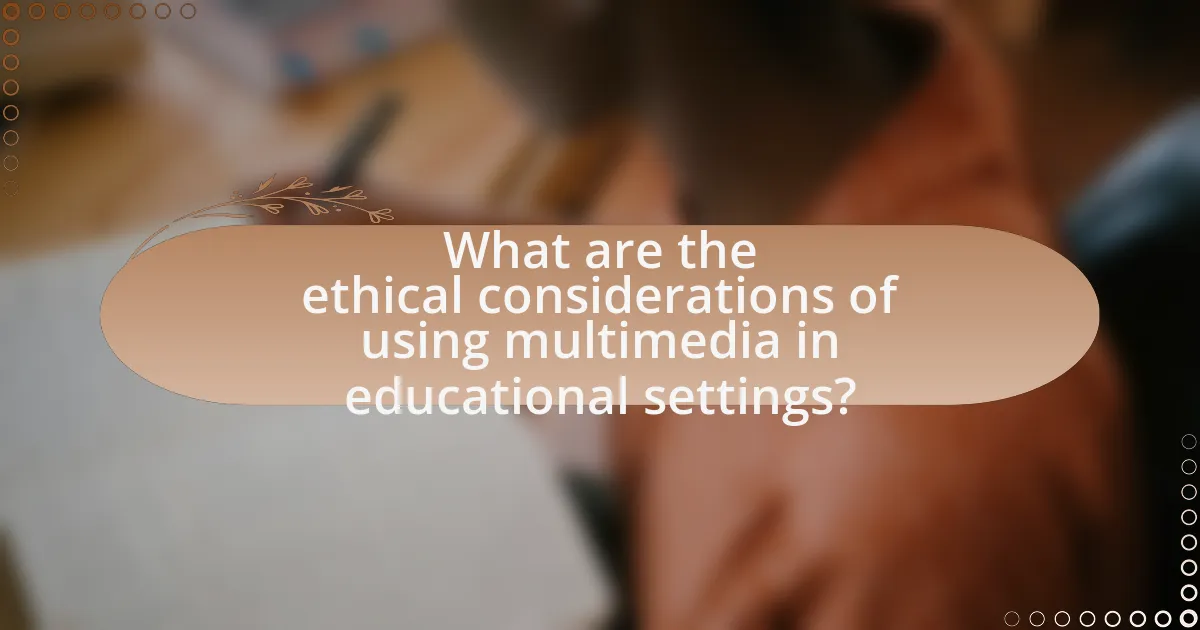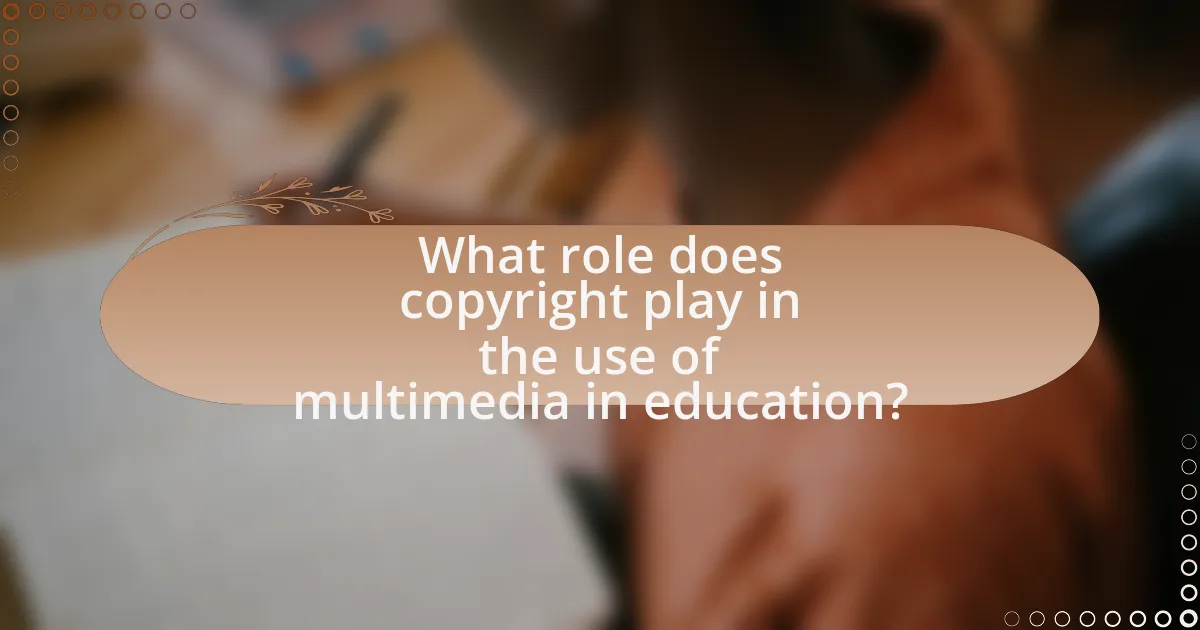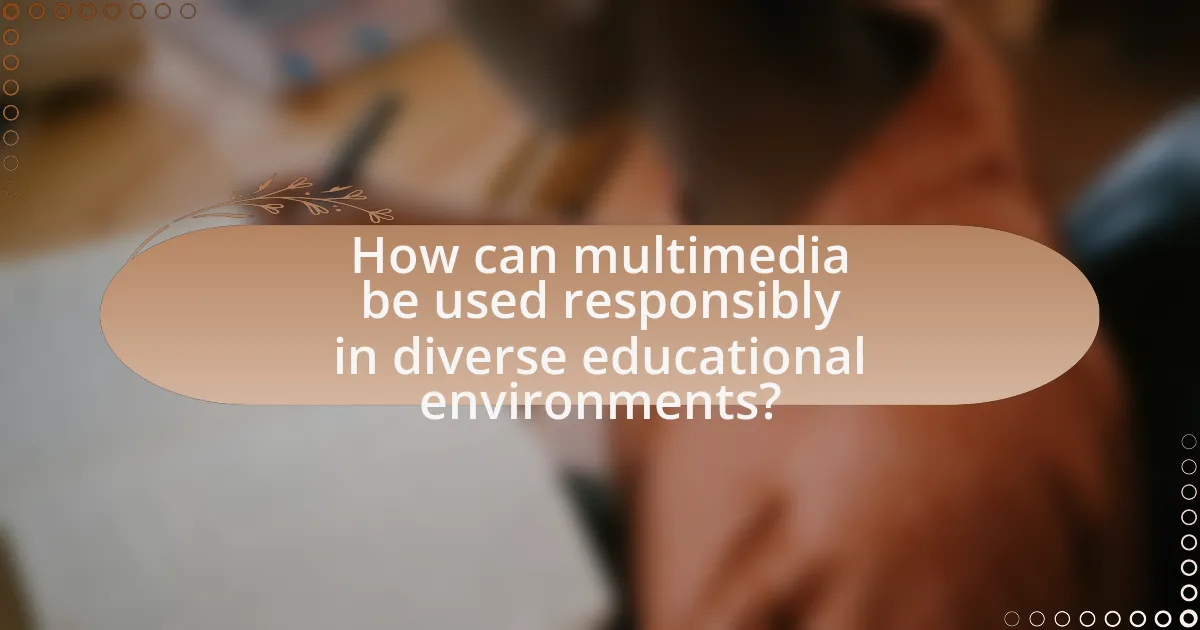The article examines the ethical considerations of using multimedia in educational settings, focusing on issues such as accessibility, copyright, misinformation, and privacy concerns. It highlights the positive impact of multimedia on student learning and engagement, emphasizing the effectiveness of interactive resources in catering to diverse learning styles. Additionally, the article addresses potential risks associated with multimedia use, including distraction and bias, and outlines best practices for educators to ensure ethical integration of multimedia, including adherence to copyright laws and promoting inclusivity. The discussion also covers strategies for assessing the effectiveness of multimedia in teaching and resources available for educators to enhance their multimedia skills.

What are the ethical considerations of using multimedia in educational settings?
The ethical considerations of using multimedia in educational settings include issues of accessibility, copyright, and the potential for misinformation. Accessibility ensures that all students, regardless of ability, can engage with multimedia content; for instance, providing captions for videos supports learners with hearing impairments. Copyright concerns arise when educators use copyrighted materials without permission, which can lead to legal repercussions; according to the U.S. Copyright Office, fair use guidelines allow limited use under specific conditions. Additionally, the risk of misinformation is significant, as multimedia can present biased or inaccurate information, necessitating critical evaluation of sources. These considerations highlight the need for responsible and informed use of multimedia in education.
How does multimedia impact student learning and engagement?
Multimedia significantly enhances student learning and engagement by catering to diverse learning styles and increasing interactivity. Research indicates that students exposed to multimedia resources, such as videos, animations, and interactive simulations, demonstrate improved retention and understanding of complex concepts. For instance, a study published in the Journal of Educational Psychology found that students who learned through multimedia presentations scored 30% higher on assessments compared to those who received traditional instruction. This improvement is attributed to the ability of multimedia to create a more immersive learning environment, fostering greater motivation and participation among students.
What types of multimedia are most effective in enhancing learning outcomes?
Interactive multimedia, such as simulations and educational games, are most effective in enhancing learning outcomes. Research indicates that these types of multimedia engage learners actively, leading to improved retention and understanding of complex concepts. For instance, a study by Hattie (2009) found that interactive learning environments can increase student achievement by up to 30%. Additionally, multimedia presentations that combine visuals, audio, and text cater to various learning styles, further supporting diverse educational needs.
How does multimedia cater to different learning styles?
Multimedia caters to different learning styles by integrating various formats such as text, audio, video, and interactive elements, which accommodate visual, auditory, and kinesthetic learners. For instance, visual learners benefit from graphics and videos, auditory learners engage with spoken content, and kinesthetic learners interact with simulations or hands-on activities. Research by Fleming and Mills (1992) identifies these learning styles and emphasizes that multimedia can enhance retention and understanding by appealing to diverse preferences. This approach not only fosters inclusivity but also improves educational outcomes by addressing the unique needs of each learner.
What are the potential risks associated with multimedia use in education?
The potential risks associated with multimedia use in education include distraction, misinformation, and accessibility issues. Distraction occurs when students focus more on multimedia elements than on the educational content, which can hinder learning outcomes. Misinformation arises from the prevalence of unverified or biased content in multimedia resources, potentially leading to the spread of false information among students. Accessibility issues can prevent students with disabilities from fully engaging with multimedia materials, thereby creating inequities in educational opportunities. According to a study by the National Center for Accessible Media, approximately 20% of students with disabilities face challenges in accessing standard multimedia educational content, highlighting the need for inclusive design in educational resources.
How can multimedia contribute to misinformation or bias in educational content?
Multimedia can contribute to misinformation or bias in educational content by presenting information in a way that emphasizes certain perspectives while downplaying others. For instance, visual elements such as images and videos can evoke emotional responses that may lead viewers to accept biased narratives without critical evaluation. Research indicates that people are more likely to remember and be influenced by visual information, which can skew their understanding of a topic if the visuals are selectively chosen or misleading. A study published in the journal “Communication Research” by researchers at the University of Southern California found that emotionally charged images can significantly affect viewers’ perceptions and beliefs, highlighting the potential for multimedia to distort factual information.
What privacy concerns arise from using multimedia in classrooms?
Using multimedia in classrooms raises significant privacy concerns, primarily related to data collection and surveillance. The integration of technology often involves the collection of personal information from students, including their images, voices, and learning behaviors, which can be stored and analyzed by educational platforms. Research indicates that 70% of educational technology tools collect student data, raising alarms about unauthorized access and potential misuse of this information. Furthermore, the use of video conferencing and recording tools can lead to unintentional exposure of students’ personal environments, compromising their privacy. These concerns highlight the need for stringent data protection measures and clear policies regarding the use of multimedia in educational settings.
How can educators ensure ethical multimedia use?
Educators can ensure ethical multimedia use by adhering to copyright laws and promoting fair use principles. This involves obtaining proper licenses for multimedia content, using resources from reputable educational platforms, and providing attribution to original creators. According to the U.S. Copyright Office, fair use allows limited use of copyrighted material without permission under specific circumstances, such as for educational purposes, which educators should clearly understand and apply. Additionally, educators should foster a culture of respect for intellectual property among students, teaching them the importance of ethical practices in multimedia usage.
What guidelines should educators follow when selecting multimedia resources?
Educators should follow guidelines that prioritize relevance, accessibility, and copyright compliance when selecting multimedia resources. Relevance ensures that the materials align with educational objectives and the curriculum, enhancing student engagement and learning outcomes. Accessibility involves choosing resources that are usable by all students, including those with disabilities, which is supported by the Web Content Accessibility Guidelines (WCAG). Copyright compliance is crucial to avoid legal issues; educators must ensure that they have the right to use the materials, which can be verified through licenses or fair use policies. These guidelines help maintain ethical standards in educational settings while promoting effective teaching practices.
How can educators promote digital literacy among students?
Educators can promote digital literacy among students by integrating technology into the curriculum and providing hands-on experiences with digital tools. This approach allows students to engage with various multimedia resources, enhancing their understanding of digital content creation, evaluation, and ethical use. Research indicates that students who participate in technology-rich learning environments demonstrate improved digital skills and critical thinking abilities. For instance, a study by the International Society for Technology in Education found that effective integration of technology in education leads to higher levels of student engagement and achievement in digital literacy.

What role does copyright play in the use of multimedia in education?
Copyright plays a critical role in the use of multimedia in education by protecting the intellectual property rights of creators while also guiding educators on the legal use of such materials. This legal framework ensures that educators must obtain permission or licenses to use copyrighted multimedia, such as videos, images, and music, in their teaching materials. For instance, the U.S. Copyright Act of 1976 provides specific exemptions for educational use under the fair use doctrine, allowing limited use of copyrighted materials without permission for purposes like criticism, comment, news reporting, teaching, scholarship, or research. However, the application of fair use can be complex and context-dependent, requiring educators to assess factors such as the purpose of use, the nature of the copyrighted work, the amount used, and the effect on the market value of the original work. Thus, understanding copyright is essential for educators to navigate the ethical and legal landscape of multimedia use in educational settings.
How can educators navigate copyright laws when using multimedia?
Educators can navigate copyright laws when using multimedia by understanding the principles of fair use, obtaining necessary permissions, and utilizing resources that are in the public domain or licensed under Creative Commons. Fair use allows limited use of copyrighted material without permission for educational purposes, but it requires consideration of factors such as the purpose of use, the nature of the work, the amount used, and the effect on the market value. Additionally, educators should seek licenses for copyrighted materials when fair use does not apply and can access a wealth of multimedia resources that are freely available for educational use, ensuring compliance with copyright laws while enriching their teaching materials.
What are the implications of fair use in educational settings?
Fair use in educational settings allows educators and students to use copyrighted materials without permission under certain conditions, promoting access to knowledge and learning. This legal doctrine supports the use of materials for teaching, scholarship, and research, provided that the use is transformative, non-commercial, and does not significantly impact the market value of the original work. For instance, the 1976 Copyright Act outlines four factors to consider when determining fair use: the purpose and character of the use, the nature of the copyrighted work, the amount used, and the effect on the market for the original work. These guidelines help educators navigate the balance between copyright protection and the need for educational resources, ensuring that the use of multimedia in classrooms fosters learning while respecting intellectual property rights.
How can educators find copyright-compliant multimedia resources?
Educators can find copyright-compliant multimedia resources by utilizing platforms that offer Creative Commons-licensed content, such as Flickr, Wikimedia Commons, and YouTube. These platforms provide access to a wide range of multimedia resources that are explicitly marked for reuse under specific conditions, ensuring compliance with copyright laws. For instance, Creative Commons licenses allow educators to use, share, and adapt materials as long as they follow the terms set by the license, such as attribution or non-commercial use. Additionally, educators can access databases like the Internet Archive and educational repositories that curate copyright-compliant materials, further supporting ethical multimedia use in educational settings.
What are the consequences of violating copyright in educational contexts?
Violating copyright in educational contexts can lead to legal repercussions, including lawsuits and financial penalties. Educational institutions may face significant fines, which can range from hundreds to thousands of dollars, depending on the severity of the infringement. Additionally, educators and students may encounter disciplinary actions, such as suspension or expulsion, if found guilty of copyright violations. The U.S. Copyright Act of 1976 provides the framework for these legal consequences, emphasizing the importance of respecting intellectual property rights in educational settings.
How can institutions protect themselves from copyright infringement claims?
Institutions can protect themselves from copyright infringement claims by implementing comprehensive copyright policies and conducting regular training for staff and students on copyright laws. Establishing clear guidelines on the use of copyrighted materials, including obtaining necessary licenses and permissions, is essential. Additionally, institutions should utilize resources such as Creative Commons licenses, which allow for the legal use of certain materials under specified conditions. According to the U.S. Copyright Office, educational institutions can also rely on the fair use doctrine, which permits limited use of copyrighted material without permission for educational purposes, provided it meets specific criteria. By actively promoting awareness and adherence to copyright laws, institutions can significantly reduce the risk of infringement claims.

How can multimedia be used responsibly in diverse educational environments?
Multimedia can be used responsibly in diverse educational environments by ensuring inclusivity, promoting critical thinking, and adhering to copyright laws. Educators should select multimedia resources that reflect the diverse backgrounds of students, fostering an inclusive atmosphere that respects cultural differences. For instance, using videos and images that represent various cultures can enhance engagement and understanding among students from different backgrounds. Additionally, multimedia should be employed to encourage critical thinking by prompting discussions and reflections on the content presented, rather than passively consuming information. Research indicates that interactive multimedia can improve learning outcomes by engaging students actively (Mayer, 2009, “Multimedia Learning”). Furthermore, educators must comply with copyright laws by using licensed materials or those in the public domain, ensuring that the rights of creators are respected. This responsible approach not only enhances the educational experience but also models ethical behavior for students.
What strategies can be implemented to ensure inclusivity in multimedia use?
To ensure inclusivity in multimedia use, educational institutions should implement strategies such as providing alternative text for images, using captions for videos, and ensuring compatibility with screen readers. These strategies enhance accessibility for individuals with visual or hearing impairments, thereby fostering an inclusive learning environment. Research indicates that approximately 15% of the global population experiences some form of disability, highlighting the necessity for accessible multimedia (World Health Organization, 2021). By adopting these practices, educators can create a more equitable educational experience for all students.
How can multimedia be adapted for students with disabilities?
Multimedia can be adapted for students with disabilities by incorporating features such as captions, audio descriptions, and alternative text. These adaptations ensure that content is accessible to individuals with hearing, visual, or cognitive impairments. For instance, research indicates that providing captions can improve comprehension for students with hearing disabilities, while audio descriptions enhance understanding for those with visual impairments. Additionally, using user-friendly interfaces and customizable settings allows students to tailor their learning experiences according to their specific needs, promoting inclusivity in educational environments.
What role does cultural sensitivity play in selecting multimedia content?
Cultural sensitivity plays a crucial role in selecting multimedia content by ensuring that the material is respectful and inclusive of diverse cultural perspectives. This sensitivity helps educators avoid reinforcing stereotypes or biases that could alienate or offend students from different backgrounds. For instance, research indicates that culturally relevant pedagogy enhances student engagement and learning outcomes, as it acknowledges and values students’ cultural identities. By incorporating multimedia that reflects a variety of cultures, educators can create a more equitable learning environment that fosters understanding and respect among students.
What best practices should educators follow for ethical multimedia integration?
Educators should prioritize copyright compliance, ensuring that all multimedia content used in educational settings is either original, licensed, or falls under fair use. This practice protects intellectual property rights and fosters respect for creators. Additionally, educators should provide proper attribution for all multimedia resources, which reinforces ethical standards and promotes academic integrity. Furthermore, they should consider the accessibility of multimedia materials, ensuring that all students, including those with disabilities, can engage with the content. Research indicates that inclusive practices enhance learning outcomes for diverse student populations. Lastly, educators should critically evaluate the relevance and accuracy of multimedia content to ensure it aligns with educational goals and supports effective learning.
How can educators assess the effectiveness of multimedia in their teaching?
Educators can assess the effectiveness of multimedia in their teaching by evaluating student engagement, comprehension, and retention of information. They can utilize surveys and feedback forms to gather student perceptions on multimedia resources, measuring how these tools enhance learning experiences. Research indicates that multimedia can improve retention rates by up to 50% compared to traditional methods, as shown in studies like Mayer’s Cognitive Theory of Multimedia Learning, which emphasizes the benefits of dual-channel processing in learning. Additionally, educators can analyze performance metrics, such as test scores and assignment completion rates, to quantify the impact of multimedia on student outcomes.
What resources are available for educators to improve their multimedia skills?
Educators can improve their multimedia skills through various resources such as online courses, workshops, and professional development programs. Platforms like Coursera and edX offer courses specifically focused on multimedia design and digital storytelling, enabling educators to enhance their technical skills and pedagogical approaches. Additionally, organizations like the International Society for Technology in Education (ISTE) provide resources, webinars, and conferences that focus on integrating multimedia into teaching practices. Research indicates that educators who engage in continuous professional development are more effective in utilizing multimedia tools, leading to improved student engagement and learning outcomes.